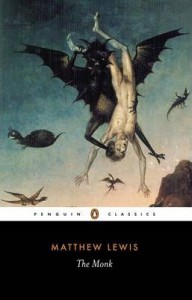
The Monk by M. G. Lewis

The Monk is said to be the archetypal Gothic novel. Sure enough, it has monks and nuns behaving badly ("behaving badly" is an understatement, really), ghosts, sex, bandits, rape, incest, violent mob and devilish pact. I had high expectation for this novel.
The titular monk is Ambrosio, a man so devout with conducts so exemplary that he's made an abbot at the age of thirty. Problem is, he's not as good as everybody (including himself) thinks he is. From the start, readers get a glimpse of his real character, which is full of vanity and self-righteousness. Ambrosio looks down on his fellow men (and women) and shows a surprising lack of self-awareness for someone thought so wise. He doesn't seem to realize that it's easy to be good and proper in the security of a cloister, and that one's integrity is measured in the face of temptation, not in its absence.
Anyway, Ambrosio meets this novice, who idolizes him, but who is actually a woman called Matilda. She bought her way to the abbey because she wanted to be close to Ambrosio, a man with whom she thought she could connect intellectually. Ambrosio tells her to leave once he finds out about her real identity, but one beauteous orb (don't ask) later, he's inclined to let her stay for three days.
In a twist of event too fantastical to believe--involving a venomous serpent and some sucking--Ambrosio ends up having sex with Matilda, who's on the brink of death. From this point onward, everything goes downhill for Ambrosio. I mean, yeah, he gets to have a lot of sex with Matilda, who made a pact with the devil to prolong her time on earth so that she could be his secret sex buddy. But he soon grows tired of her, which is a problem if you're a horny monk with no women around you bar one. And then, with the help of Matilda, who transitioned from the role of a lover to a pimp seemingly without difficulty, Ambrosio comes out to the world in search for a new sex object, getting closer and closer to eternal damnation in the process.
Apart from Ambrosio's story, the novel also features several sub-plots, all of which converges on the climactic episode in the crypt. There's the story of Antonia, a girl who comes to Madrid after her mother's death to seek the help and acknowledgement of a wealthy relative; Agnes, a young woman who enters the convent following the promise of her parents and the ruse of her aunt; and Don Raymond, Agnes' lover who had many interesting experiences throughout his road-trip across Europe (my favorite is the one with the Bleeding Nun).
However, I can't say that I enjoyed the novel. The meandering storytelling often left me bored, and the cultural and temporal distance has reduced much of its shock value for me. It seems that Gothic novels just aren't for me.
 1
1








